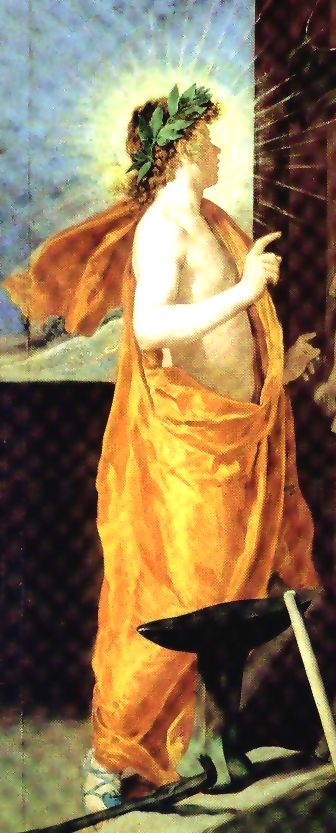Hephaestus, Hephaistos or Hefesto
Adopted by Romans as Vulcan, he was god of all craftsmen and smiths, lord of the metals and the "technic" and one of the most popular deities in Athens altogether with Athena or Athenea (see Athena), with whom he even shared some temples. His name was taken as a derivation of hemero-phaistos "that who shines during daytime" (the sun) when Athena was identified as a moon-goddess, forming both a sort of duality. In Rome, he was specially worshipped in the Vesubio and the Etna, since he was associated with volcanos, the places with whose fire he worked in the craft and named its god.
When born, his mother threw him from the Olympus for being lame, but the child, after falling during one entire day, he fell in the sea, where it was found by the goddess Tetys and her daughter Eurynome. They brought him up and the child installed his first craft in Lemnos, where he fashioned beautiful objects of every kind for them.
After 9 years (number showing his subordination to the moon) he went to dwell in the Olympus with the gods, not being clear the reason why he did it: some say Hera met Tetis once and forced her to talk about the origin of one of the jewels Hephaistos had made for her.

Vulcan (Hephaistos) in a fragment of "Vulcan's Forge", painted by Velázquez (1599-1660) (del Prado Museum, Madrid).
He was thrown for a second time from Mount Olympus when he interfered in a conversation between Hera and Zeus to defend his mother, and he's thought to have broken his legs in the fall and, though he was immortal, he was very weak when men found him. Finally, he was forgiven by Zeus and returned to the Olympus, where he dwelt in a palace made of bronze and he had two beautiful golden android women that helped him in every task. He created a forge there that worked restless day and night with the help of the Cyclopes. He was believed to have "fashioned" Achilles' arms, Eneas', Agamemnon's ceptre and the first mortal woman: Pandora, who released all the sins and evils from an enchanted box owing to his curiosity.
Hephaistos was married by Zeus with Aphrodite, who would later be well known for her affairs with Adonis and Mars, among other immortal and mortal lovers (see Aphrodite). That made the god forge an invisible metallic net that captured Aphrodite and Mars so that the other gods could see and laugh at the couple.
His cult is thought to have been initiated in Minor Asia.